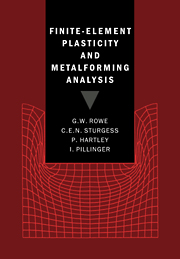Book contents
- Frontmatter
- Contents
- Preface
- Acknowledgements
- Nomenclature
- 1 General introduction to the finite-element method
- 2 Basic formulation for elastic deformation
- 3 Small-deformation elastic–plastic analysis
- 4 Finite-element plasticity on microcomputers
- 5 Finite-strain formulation for metalforming analysis
- 6 Implementation of the finite-strain formulation
- 7 Practical applications
- 8 Future developments
- Appendix 1 Derivation of small-strain [B] matrix for 2-D triangular element
- Appendix 2 Derivation of elastic [D] matrix
- Appendix 3 Derivation of elastic–plastic [D] matrix
- Appendix 4 Derivation of small-strain stiffness matrix [K] for plane-stress triangular element
- Appendix 5 Solution of stiffness equations by Gaussian elimination and back-substitution
- Appendix 6 Imposition of boundary conditions
- Appendix 7 Relationship between elastic moduli E, G and κ
- Appendix 8 Vectors and tensors
- Appendix 9 Stress in a deforming body
- Appendix 10 Stress rates
- Appendix 11 Listing of BASIC program for small-deformation elastic–plastic FE analysis
- Bibliography
- Index
5 - Finite-strain formulation for metalforming analysis
Published online by Cambridge University Press: 22 September 2009
- Frontmatter
- Contents
- Preface
- Acknowledgements
- Nomenclature
- 1 General introduction to the finite-element method
- 2 Basic formulation for elastic deformation
- 3 Small-deformation elastic–plastic analysis
- 4 Finite-element plasticity on microcomputers
- 5 Finite-strain formulation for metalforming analysis
- 6 Implementation of the finite-strain formulation
- 7 Practical applications
- 8 Future developments
- Appendix 1 Derivation of small-strain [B] matrix for 2-D triangular element
- Appendix 2 Derivation of elastic [D] matrix
- Appendix 3 Derivation of elastic–plastic [D] matrix
- Appendix 4 Derivation of small-strain stiffness matrix [K] for plane-stress triangular element
- Appendix 5 Solution of stiffness equations by Gaussian elimination and back-substitution
- Appendix 6 Imposition of boundary conditions
- Appendix 7 Relationship between elastic moduli E, G and κ
- Appendix 8 Vectors and tensors
- Appendix 9 Stress in a deforming body
- Appendix 10 Stress rates
- Appendix 11 Listing of BASIC program for small-deformation elastic–plastic FE analysis
- Bibliography
- Index
Summary
INTRODUCTION
The first applications of the FEM were concerned with structural problems, and so it is not surprising that when the FEM began to be applied to the modelling of plastic deformation, this was viewed simply as an extension of non-linear elastic behaviour, with the elastic stress/strain matrix in the FE formulation replaced by an appropriate plastic one, as described in Chapter 3. When the amounts of plastic deformation and material displacement are small, this is a valid approach and is often used in the study of plastic failure of structures such as pressure vessels. The small-strain technique also has the advantage of being easily understood, thus providing a good introduction to the principles and underlying FE plasticity, and of being easily incorporated into available elastic FE programs.
As the examples in the previous chapter show, the small-strain approach can give good approximations to the overall pattern of deformation in certain simple forming processes. However, this technique cannot accurately predict the values of important workpiece parameters, such as the components of strain and stress, particularly if the metalforming process involves appreciable material rotation. This is due partly to the nature of elastic–plastic deformation, for which correct definitions of stress and strain increment must be chosen, and partly to the large total and incremental strains involved in metalforming, which require special numerical techniques for their evaluation.
This chapter re-examines the FEM in the light of these considerations in order to derive a formulation that is able to model large-strain elastic–plastic deformation.
- Type
- Chapter
- Information
- Finite-Element Plasticity and Metalforming Analysis , pp. 66 - 79Publisher: Cambridge University PressPrint publication year: 1991

